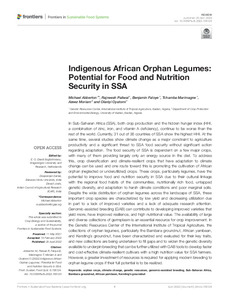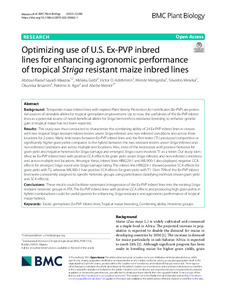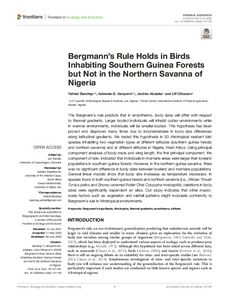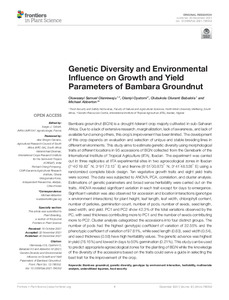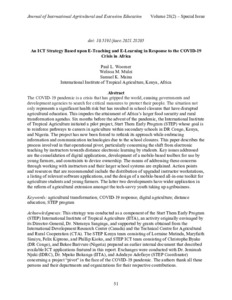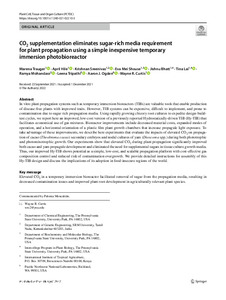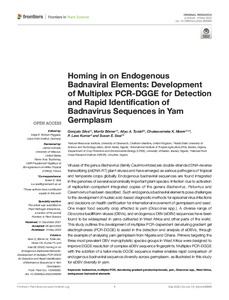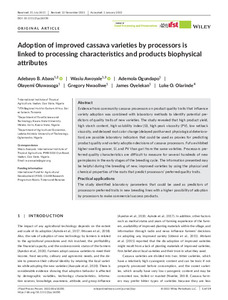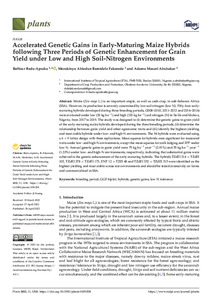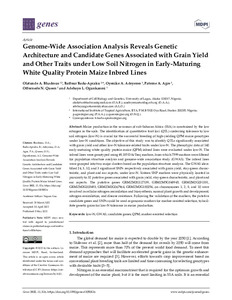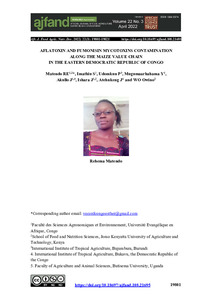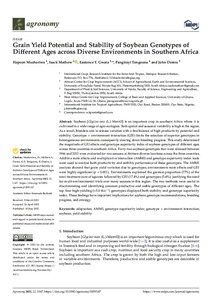Welcome to the International Institute of Tropical Agriculture Research Repository
Journal and Journal Articles: Recent submissions
Now showing items 761-780 of 5266
-
Indigenous African orphan legumes: potential for food and nutrition security in SSA
(2022)In Sub-Saharan Africa (SSA), both crop production and the hidden hunger index (HHI, a combination of zinc, iron, and vitamin A deficiency), continue to be worse than the rest of the world. Currently, 31 out of 36 countries of SSA show the highest HHI. At the same time, several studies show climate change as a major constraint to agriculture productivity and a significant threat to SSA food security without significant action regarding adaptation. The food security of SSA is dependent on a few major ... -
Inheritance of resistance to three endemic viral diseases of cowpea in Nigeria
(2022-06-22)Mosaic diseases, caused by bean common mosaic virus-blackeye cowpea mosaic strain (BCMV-BlCM), southern bean mosaic virus (SBMV), and cucumber mosaic virus (CMV), hamper the productivity of cowpea (Vigna unguiculata (L.) Walp.). Under single or mixed infections, these endemic viruses significantly reduce cowpea yield in sub-Saharan Africa. Planting resistant varieties is the most effective control method. Knowledge of the mode of inheritance of viral resistance is crucial in developing resistant ... -
"Stop calling me a youth!": Understanding and analysing heterogeneity among Ugandan youth Agripreneurs
(2022-06-12)The African “youth” population is growing at a fast and steady pace, attracting attention from scholars, policymakers, and politicians. Yet, we know relatively little about this large and heterogeneous segment of the population. This paper presents data from 110 interviews and ten focus groups with youth engaged in commercial agriculture across all four regions of Uganda. Capitalising on this ethnographic data, we provide an analytical framework for studying complexity among the heterogeneous ... -
Optimizing use of U.S. Ex-PVP inbred lines for enhancing agronomic performance of tropical Striga resistant maize inbred lines
(2022-06-10)Background Temperate maize inbred lines with expired Plant Variety Protection Act certificates (Ex-PVP) are potential sources of desirable alleles for tropical germplasm improvement. Up to now, the usefulness of the Ex-PVP inbred lines as a potential source of novel beneficial alleles for Striga hermonthica resistance breeding to enhance genetic gain in tropical maize has not been reported. Results This study was thus conducted to characterize the combining ability of 24 Ex-PVP inbred lines ... -
Bergmann's rule holds in birds inhabiting southern Guinea forests but not in the northern Savanna of Nigeria
(2022)The Bergmann’s rule predicts that in endotherms, body sizes will differ with respect to thermal gradients. Larger bodied individuals will inhabit colder environments while in warmer environments, individuals will be smaller-bodied. This hypothesis has been proved and disproved many times due to inconsistencies in body size differences along latitudinal gradients. We tested this hypothesis in 30 Afrotropical resident bird species inhabiting two vegetation types at different latitudes (southern ... -
Genetic Diversity and Environmental Influence on Growth and Yield Parameters of Bambara Groundnut
(2021-12-20)Bambara groundnut (BGN) is a drought-tolerant crop majorly cultivated in sub-Saharan Africa. Due to a lack of extensive research, marginalization, lack of awareness, and lack of available fund among others, this crop’s improvement has been limited. The development of this crop depends on evaluation and selection of unique and stable breeding lines in different environments. This study aims to estimate genetic diversity using morphological traits at different locations in 95 accessions of BGN ... -
Indifferent to difference? Understanding the unequal impacts of farming technologies among smallholders. A review
(2022)With many of the world’s poor engaged in agriculture, agricultural development programmes often aim to improve livelihoods through improved farming practices. Research on the impacts of agricultural technology interventions is dominated by comparisons of adopters and non-adopters. By contrast, in this literature study, we critically review how technology evaluation studies assess differentiated impacts in smallholder farming communities. We searched systematically for studies which present ... -
An ICT strategy based upon E-Teaching and E-Learning in response to the COVID-19 crisis in Africa
(2021)The COVID-19 pandemic is a crisis that has gripped the world, causing governments and development agencies to search for critical measures to protect their people. The situation not only represents a significant health risk but has resulted in school closures that have disrupted agricultural education. This impedes the attainment of Africa’s larger food security and rural transformation agendas. Six months before the advent of the pandemic, the International Institute of Tropical Agriculture ... -
CO2 supplementation eliminates sugar-rich media requirement for plant propagation using a simple inexpensive temporary immersion photobioreactor
(2022)In vitro plant propagation systems such as temporary immersion bioreactors (TIBs) are valuable tools that enable production of disease-free plants with improved traits. However, TIB systems can be expensive, difficult to implement, and prone to contamination due to sugar rich propagation media. Using rapidly growing chicory root cultures to expedite design-build-test cycles, we report here an improved, low-cost version of a previously reported Hydrostatically-driven TIB (Hy-TIB) that facilitates ... -
Analyses of genetic diversity and population structure of sesame (Sesamum indicum L.) germplasm collections through seed oil and fatty acid compositions and SSR markers
(2022)Knowledge of the genetic profiles of diverse germplasm collections of sesame using seed oil, fatty acid contents, and molecular markers is a prerequisite to develop market-preferred cultivars with quantity and quality oil. The objective of this study was to determine the genetic diversity and relationships among Ethiopia’s sesame germplasm collections using seed oil content and fatty acid compositions and diagnostic simple sequence repeat (SSR) markers to select genetically complementary and ... -
Understanding the perceptions of secondary school youth toward agricultural careers in Democratic Republic of Congo, Kenya and Nigeria
(2020)Youth are critical participants in the modernization of African agriculture but often their perception of farming is negative. A baseline survey of 1264 students from eight secondary schools in Democratic Republic (DR) of Congo, Kenya and Nigeria was conducted to assess their attitudes toward career pathways to agriculture and agribusiness. KoboToolBox was used to collect data online before compilation and inspection for errors in Microsoft Excel and exportation into STATA for analysis. Findings ... -
Homing in on endogenous badnaviral elements: Development of multiplex PCR-DGGE for detection and rapid identification of badnavirus sequences in yam germplasm
(2022)Viruses of the genus Badnavirus (family Caulimoviridae) are double-stranded DNA-reverse transcribing (dsDNA-RT) plant viruses and have emerged as serious pathogens of tropical and temperate crops globally. Endogenous badnaviral sequences are found integrated in the genomes of several economically important plant species. Infection due to activation of replication-competent integrated copies of the genera Badnavirus, Petuvirus and Cavemovirus has been described. Such endogenous badnaviral elements ... -
Adoption of improved cassava varieties by processors is linked to processing characteristics and products biophysical attributes
(2022)Evidence from community cassava processors on product quality traits that influence variety adoption was combined with laboratory methods to identify potential predictors of quality traits of new varieties. The study revealed that high product yield, high starch content, high solubility index (SI), high peak viscosity (PV), low setback viscosity, and delayed root color change (delayed postharvest physiological deterioration) are possible laboratory indicators that could be used as proxies for ... -
Datasets on the variations of minerals in biofortified cassava (Manihot esculenta Crantz) as a function of storage root portion, maturity and environment
(2022)Background: The accurate measurements of the mineral content of cassava roots are vital from a nutritional perspective. The research datasets were from the study assessing the influence of storage root portion, maturity, and environment on the variations of minerals in biofortified cassava roots. Methods: Twenty-five biofortified clones with three varieties as checks were harvested 12 months after planting from five different environments. Also, a different thirty-nine (39) biofortified cassava ... -
Identification of early and extra-early maturing tropical maize inbred lines with multiple disease resistance for enhanced maize production and productivity in sub-Saharan Africa
(2022)Maize, a staple for millions across sub-Saharan Africa (SSA), faces major biotic constraints affecting production and safety of the crop. These include the northern corn leaf blight (NCLB), southern corn leaf blight (SCLB), Curvularia leaf spot (CLS), and aflatoxin contamination by Exserohilum turcicum, Bipolaris maydis, Curvularia lunata, and Aspergillus flavus, respectively. Farmers in SSA would benefit tremendously if high yielding maize hybrids with multiple disease resistance (MDR) were ... -
Accelerated genetic gains in early-maturing maize hybrids following three periods of genetic enhancement for grain yield under low and high soil-nitrogen environments
(2022)Maize (Zea mays L.) is an important staple, as well as cash crop, in sub-Saharan Africa (SSA). However, its production is severely constrained by low soil nitrogen (low N). Fifty-four early-maturing hybrids developed during three breeding periods, (2008–2010, 2011–2013 and 2014–2016) were evaluated under low (30 kg ha−1) and high (120 kg ha−1) soil nitrogen (N) in Ile-Ife and Mokwa, Nigeria, from 2017 to 2019. The study was designed to (i) determine the genetic gains in grain yield of the ... -
Genome-wide association analysis reveals genetic architecture and candidate genes associated with grain yield and other traits under low soil nitrogen in early-maturing white quality protein maize inbred lines
(2022)Maize production in the savannas of sub-Saharan Africa (SSA) is constrained by the low nitrogen in the soils. The identification of quantitative trait loci (QTL) conferring tolerance to low soil nitrogen (low-N) is crucial for the successful breeding of high-yielding QPM maize genotypes under low-N conditions. The objective of this study was to identify QTLs significantly associated with grain yield and other low-N tolerance-related traits under low-N. The phenotypic data of 140 early-maturing ... -
Aflatoxin and fumonisin mycotoxins contamination along the maize value chain in the eastern Democratic Republic of Congo
(2022-04)Aflatoxin and fumonisin contamination was assessed in different samples along the maize value chain in different territories of South Kivu province. Kabare and Ruzizi Plain were chosen as they represent two different agroecological areas where maize is mostly produced. Twelve districts and one town were selected across the province. The stakeholders were randomly selected, and 215 maize (139 maize grain and 76 maize flour) samples were taken for laboratory analysis. The Q + kit was used to determine ... -
Grain yield potential and stability of soybean genotypes of different ages across diverse environments in southern Africa
(2022)Soybean [Glycine max (L.) Merrill] is an important crop in southern Africa where it is cultivated in a wide range of agro-ecologies. Both spatial and seasonal variability is high in the region. As a result, breeders aim to release varieties with a fine balance of high productivity potential and stability. Genotype × environment interaction (GEI) limits the selection of superior genotypes in heterogeneous environments consequently slowing down breeding progress. This study determined the magnitude ... -
Phylogeography and conservation gaps of Musa balbisiana Colla genetic diversity revealed by microsatellite markers
(2022)Collection and storage of crop wild relative (CWR) germplasm is crucial for preserving species genetic diversity and crop improvement. Nevertheless, much of the genetic variation of CWRs is absent in ex situ collections and detailed passport data are often lacking. Here, we focussed on Musa balbisiana, one of the two main progenitor species of many banana cultivars. We investigated the genetic structure of M. balbisiana across its distribution range using microsatellite markers. Accessions stored ...

